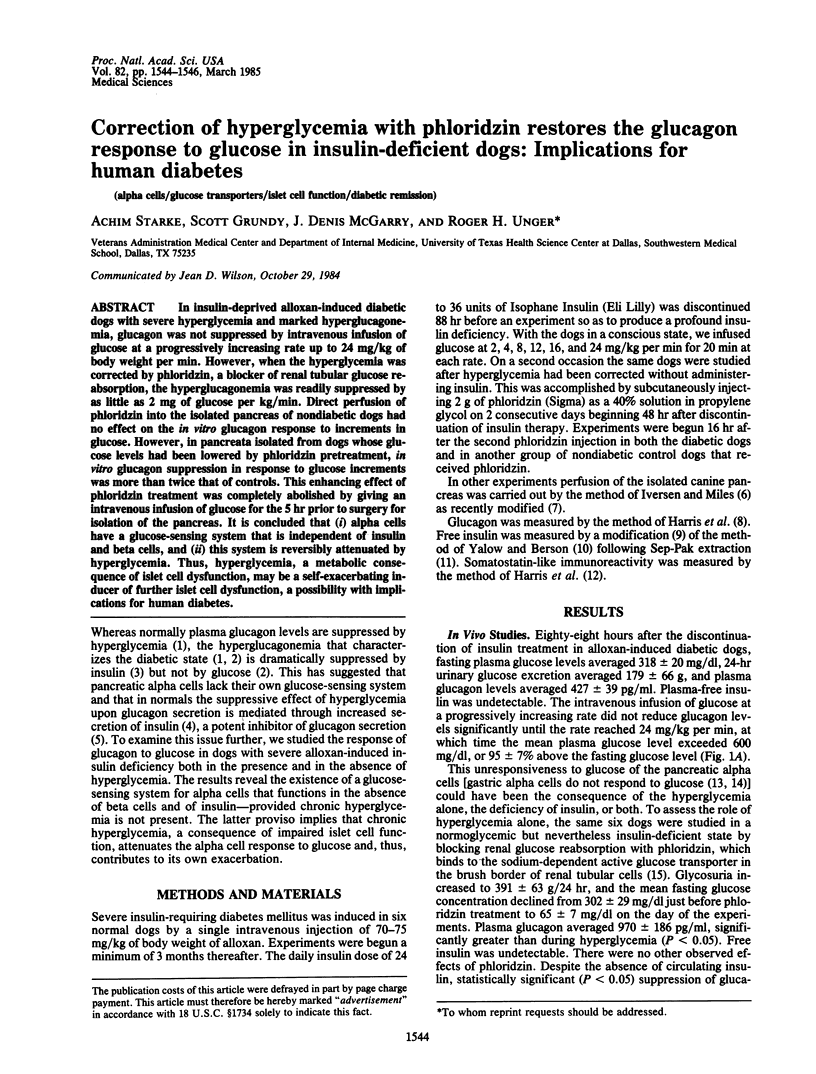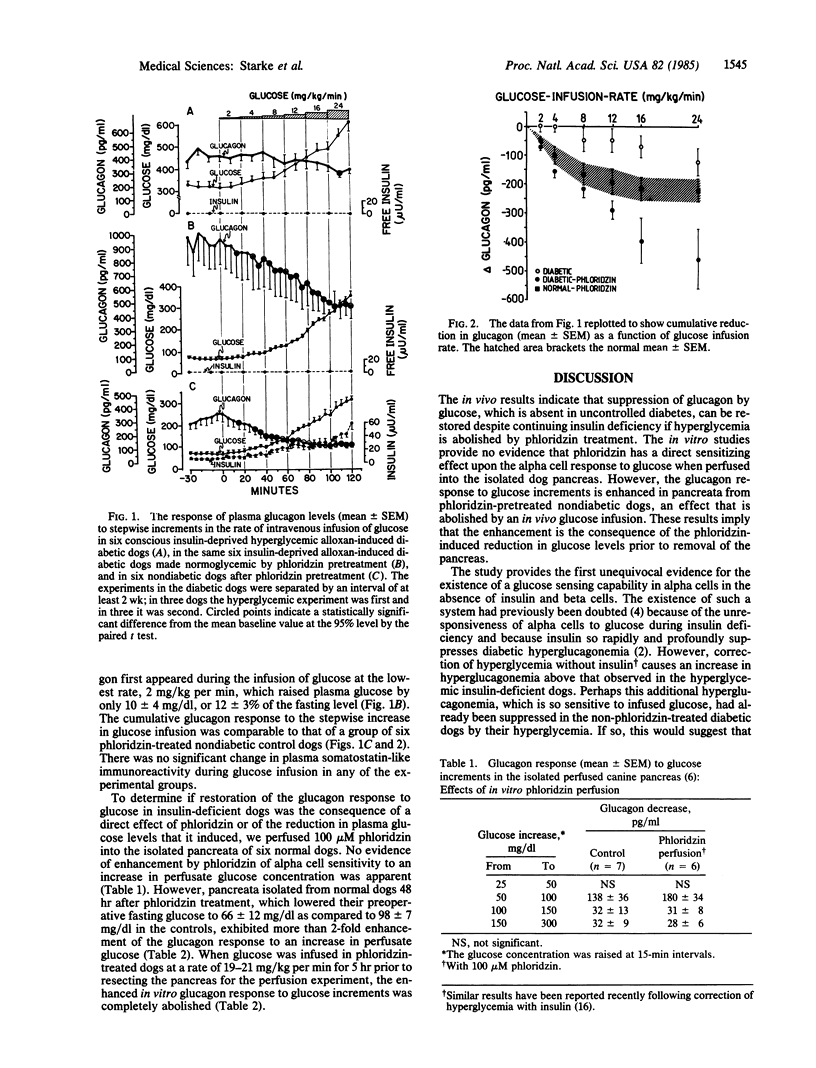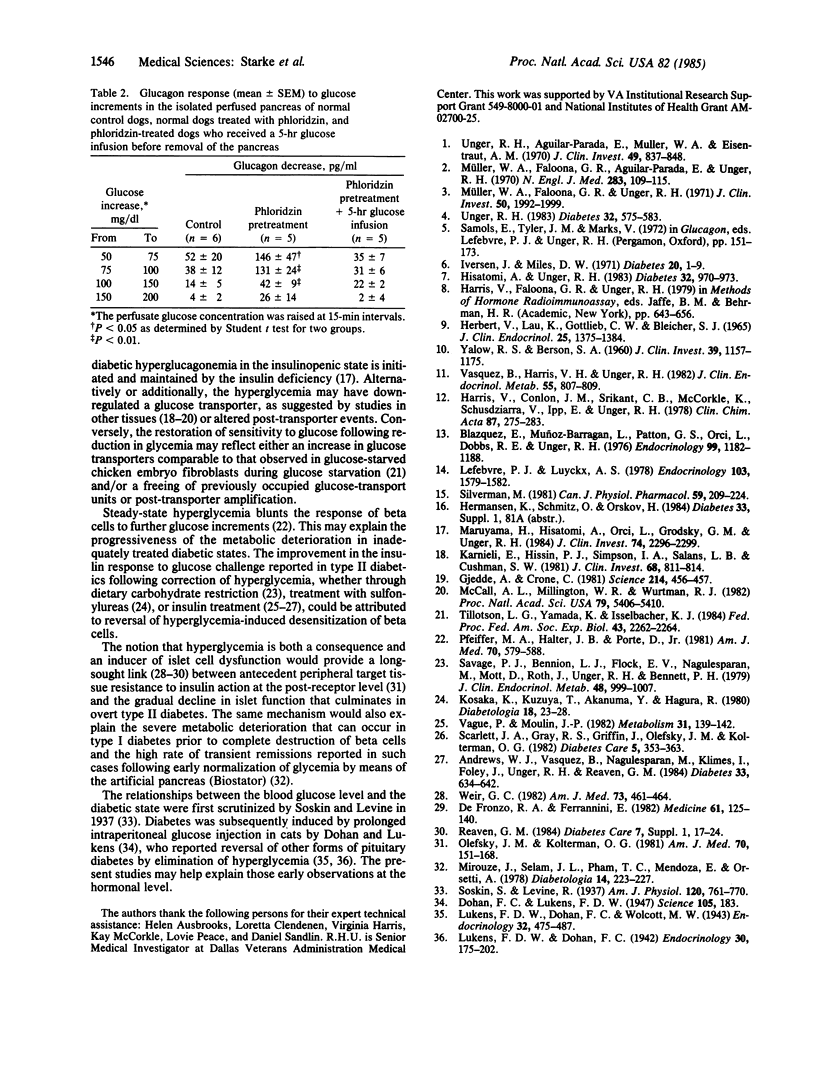Abstract
In insulin-deprived alloxan-induced diabetic dogs with severe hyperglycemia and marked hyperglucagonemia, glucagon was not suppressed by intravenous infusion of glucose at a progressively increasing rate up to 24 mg/kg of body weight per min. However, when the hyperglycemia was corrected by phloridzin, a blocker of renal tubular glucose reabsorption, the hyperglucagonemia was readily suppressed by as little as 2 mg of glucose per kg/min. Direct perfusion of phloridzin into the isolated pancreas of nondiabetic dogs had no effect on the in vitro glucagon response to increments in glucose. However, in pancreata isolated from dogs whose glucose levels had been lowered by phloridzin pretreatment, in vitro glucagon suppression in response to glucose increments was more than twice that of controls. This enhancing effect of phloridzin treatment was completely abolished by giving an intravenous infusion of glucose for the 5 hr prior to surgery for isolation of the pancreas. It is concluded that (i) alpha cells have a glucose-sensing system that is independent of insulin and beta cells, and (ii) this system is reversibly attenuated by hyperglycemia. Thus, hyperglycemia, a metabolic consequence of islet cell dysfunction, may be a self-exacerbating inducer of further islet cell dysfunction, a possibility with implications for human diabetes.
Full text
PDF


Selected References
These references are in PubMed. This may not be the complete list of references from this article.
- Andrews W. J., Vasquez B., Nagulesparan M., Klimes I., Foley J., Unger R., Reaven G. M. Insulin therapy in obese, non-insulin-dependent diabetes induces improvements in insulin action and secretion that are maintained for two weeks after insulin withdrawal. Diabetes. 1984 Jul;33(7):634–642. doi: 10.2337/diab.33.7.634. [DOI] [PubMed] [Google Scholar]
- Blazquez E., Muñoz-Barragan L., Patton G. S., Orci L., Dobbs R. E., Unger R. H. Gastric A-cell function in insulin-deprived depancreatized dogs. Endocrinology. 1976 Nov;99(5):1182–1188. doi: 10.1210/endo-99-5-1182. [DOI] [PubMed] [Google Scholar]
- DeFronzo R. A., Ferrannini E. The pathogenesis of non-insulin-dependent diabetes: an update. Medicine (Baltimore) 1982 May;61(3):125–140. doi: 10.1097/00005792-198205000-00001. [DOI] [PubMed] [Google Scholar]
- Dohan F. C., Lukens F. D. Lesions of the Pancreatic Islets Produced in Cats by Administration of Glucose. Science. 1947 Feb 14;105(2720):183–183. doi: 10.1126/science.105.2720.183. [DOI] [PubMed] [Google Scholar]
- Gjedde A., Crone C. Blood-brain glucose transfer: repression in chronic hyperglycemia. Science. 1981 Oct 23;214(4519):456–457. doi: 10.1126/science.7027439. [DOI] [PubMed] [Google Scholar]
- Harris V., Conlon J. M., Srikant C. B., McCorkle K., Schusdziarra V., Ipp E., Unger R. H. Measurements of somatostatin-like immunoreactivity in plasma. Clin Chim Acta. 1978 Jul 15;87(2):275–283. doi: 10.1016/0009-8981(78)90348-0. [DOI] [PubMed] [Google Scholar]
- Herbert V., Lau K. S., Gottlieb C. W., Bleicher S. J. Coated charcoal immunoassay of insulin. J Clin Endocrinol Metab. 1965 Oct;25(10):1375–1384. doi: 10.1210/jcem-25-10-1375. [DOI] [PubMed] [Google Scholar]
- Hisatomi A., Unger R. H. Secretin inhibits glucagon in the isolated perfused dog pancreas. Diabetes. 1983 Oct;32(10):970–973. doi: 10.2337/diab.32.10.970. [DOI] [PubMed] [Google Scholar]
- Iversen J., Miles D. W. Evidence for a feedback inhibition of insulin on insulin secretion in the isolated, perfused canine pancreas. Diabetes. 1971 Jan;20(1):1–9. doi: 10.2337/diab.20.1.1. [DOI] [PubMed] [Google Scholar]
- Karnieli E., Hissin P. J., Simpson I. A., Salans L. B., Cushman S. W. A possible mechanism of insulin resistance in the rat adipose cell in streptozotocin-induced diabetes mellitus. Depletion of intracellular glucose transport systems. J Clin Invest. 1981 Sep;68(3):811–814. doi: 10.1172/JCI110318. [DOI] [PMC free article] [PubMed] [Google Scholar]
- Kosaka K., Kuzuya T., Akanuma Y., Hagura R. Increase in insulin response after treatment of overt maturity-onset diabetes is independent of the mode of treatment. Diabetologia. 1980 Jan;18(1):23–28. doi: 10.1007/BF01228297. [DOI] [PubMed] [Google Scholar]
- Lefebvre P. J., Luyckx A. S. Glucose and insulin in the regulation of glucagon release from the isolated perfused dog stomach. Endocrinology. 1978 Nov;103(5):1579–1582. doi: 10.1210/endo-103-5-1579. [DOI] [PubMed] [Google Scholar]
- Maruyama H., Hisatomi A., Orci L., Grodsky G. M., Unger R. H. Insulin within islets is a physiologic glucagon release inhibitor. J Clin Invest. 1984 Dec;74(6):2296–2299. doi: 10.1172/JCI111658. [DOI] [PMC free article] [PubMed] [Google Scholar]
- McCall A. L., Millington W. R., Wurtman R. J. Metabolic fuel and amino acid transport into the brain in experimental diabetes mellitus. Proc Natl Acad Sci U S A. 1982 Sep;79(17):5406–5410. doi: 10.1073/pnas.79.17.5406. [DOI] [PMC free article] [PubMed] [Google Scholar]
- Mirouze J., Selam J. L., Pham T. C., Mendoza E., Orsetti A. Sustained insulin-induced remissions of juvenile diabetes by means of an external artificial pancreas. Diabetologia. 1978 Apr;14(4):223–227. doi: 10.1007/BF01219420. [DOI] [PubMed] [Google Scholar]
- Müller W. A., Faloona G. R., Aguilar-Parada E., Unger R. H. Abnormal alpha-cell function in diabetes. Response to carbohydrate and protein ingestion. N Engl J Med. 1970 Jul 16;283(3):109–115. doi: 10.1056/NEJM197007162830301. [DOI] [PubMed] [Google Scholar]
- Müller W. A., Faloona G. R., Unger R. H. The effect of experimental insulin deficiency on glucagon secretion. J Clin Invest. 1971 Sep;50(9):1992–1999. doi: 10.1172/JCI106691. [DOI] [PMC free article] [PubMed] [Google Scholar]
- Olefsky J. M., Kolterman O. G. Mechanisms of insulin resistance in obesity and noninsulin-dependent (type II) diabetes. Am J Med. 1981 Jan;70(1):151–168. doi: 10.1016/0002-9343(81)90422-8. [DOI] [PubMed] [Google Scholar]
- Pfeifer M. A., Halter J. B., Porte D., Jr Insulin secretion in diabetes mellitus. Am J Med. 1981 Mar;70(3):579–588. doi: 10.1016/0002-9343(81)90579-9. [DOI] [PubMed] [Google Scholar]
- Reaven G. M. Insulin secretion and insulin action in non-insulin-dependent diabetes mellitus: which defect is primary? Diabetes Care. 1984 May-Jun;7 (Suppl 1):17–24. [PubMed] [Google Scholar]
- Savage P. J., Bennion L. J., Flock E. V., Nagulesparan M., Mott D., Roth J., Unger R. H., Bennett P. H. Diet-induced improvement of abnormalities in insulin and glucagon secretion and in insulin receptor binding in diabetes mellitus. J Clin Endocrinol Metab. 1979 Jun;48(6):999–1007. doi: 10.1210/jcem-48-6-999. [DOI] [PubMed] [Google Scholar]
- Scarlett J. A., Gray R. S., Griffin J., Olefsky J. M., Kolterman O. G. Insulin treatment reverses the insulin resistance of type II diabetes mellitus. Diabetes Care. 1982 Jul-Aug;5(4):353–363. doi: 10.2337/diacare.5.4.353. [DOI] [PubMed] [Google Scholar]
- Silverman M. Glucose reabsorption in the kidney. Can J Physiol Pharmacol. 1981 Mar;59(3):209–224. doi: 10.1139/y81-035. [DOI] [PubMed] [Google Scholar]
- Tillotson L. G., Yamada K., Isselbacher K. J. Regulation of hexose transporters of chicken embryo fibroblasts during glucose starvation. Fed Proc. 1984 May 15;43(8):2262–2264. [PubMed] [Google Scholar]
- Unger R. H., Aguilar-Parada E., Müller W. A., Eisentraut A. M. Studies of pancreatic alpha cell function in normal and diabetic subjects. J Clin Invest. 1970 Apr;49(4):837–848. doi: 10.1172/JCI106297. [DOI] [PMC free article] [PubMed] [Google Scholar]
- Unger R. H. The Berson memorial lecture. Insulin-glucagon relationships in the defense against hypoglycemia. Diabetes. 1983 Jun;32(6):575–583. doi: 10.2337/diab.32.6.575. [DOI] [PubMed] [Google Scholar]
- Vague P., Moulin J. P. The defective glucose sensitivity of the B cell in non insulin dependent diabetes. Improvement after twenty hours of normoglycaemia. Metabolism. 1982 Feb;31(2):139–142. doi: 10.1016/0026-0495(82)90125-1. [DOI] [PubMed] [Google Scholar]
- Vasquez B., Harris V., Unger R. H. Extraction of somatostatin from human plasma on octadecylsilyl silica. J Clin Endocrinol Metab. 1982 Oct;55(4):807–809. doi: 10.1210/jcem-55-4-807. [DOI] [PubMed] [Google Scholar]
- Weir G. C. Non-insulin-dependent diabetes mellitus: interplay between B-cell inadequacy and insulin resistance. Am J Med. 1982 Oct;73(4):461–464. doi: 10.1016/0002-9343(82)90321-7. [DOI] [PubMed] [Google Scholar]
- YALOW R. S., BERSON S. A. Immunoassay of endogenous plasma insulin in man. J Clin Invest. 1960 Jul;39:1157–1175. doi: 10.1172/JCI104130. [DOI] [PMC free article] [PubMed] [Google Scholar]


